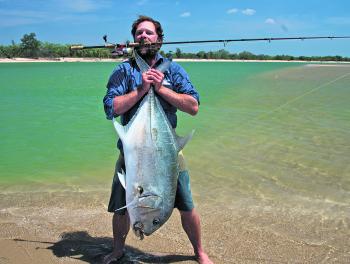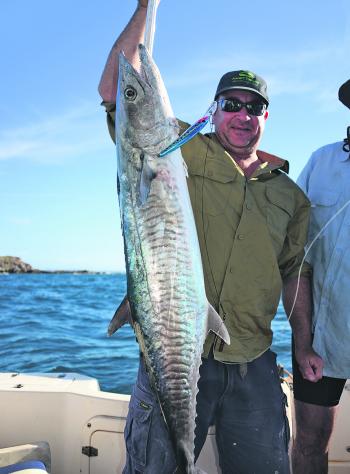August in Cape York can be a real break-out month as we move into a few of the driest, most settled months of the year. By the end of this month and heading into September, a few calm periods will be restoring faith to East Coast anglers that the weather could ever be good again.
During this period, many of shallow offshore reefs and shoals on both sides of the Cape will fish well. Taking a look at some of the fishing presenting itself though a range of shallow to medium depths is a good way to tackle some iconic species.
Spanish, grey, school and broad-barred mackerel are a fantastic and fuel efficient way to put a few fillets on the table. They present some of the most consistent tasting and best edible-fillet recoveries of all the fish species. Even the smaller mackerel prove delicious if bled and put in an ice slurry immediately after capture.
August, September and October are a great time to target mackies on a variety of methods, right the way around Cape York. On the West Coast in particular, finding inshore schools of baitfish with sporadic birds flying overhead is usually a signal that grey and school mackerel are underneath, terrorising their prey. Small spoons, metal slices and soft plastics will account for these zippy little fish. Unfortunately, bite-offs are common, however mono leader definitely produces more bites than wire.
Their big cousins the Spanish mackerel are a different fish altogether. Growing from spirited little toothy critters right up to oceanic monsters, these are a welcome catch to most angers. Far northern anglers have nearly all been out chasing Spaniards at some time or another. They are the mainstay of the far northern sports fishing scene.
Mackerel like a bit of run-in the tide, preferring to ambush prey around pressure points created by rocks, reef and current lines. Towing baits, bibbed or cranking lures, poppers, spoons slugs and large plastics are great ways to tussle with a big Spanish. Just remember when they are chasing something they can travel supersonic speeds, so wind and troll quicker after you see a marauding pack close in on your lures.
Large cobia are always a possibility on any piece of offshore structure right the way down the West coast. Certain spots seem to congregate cobia on the East Coast, rocky reefs and inshore shoals being amongst some of the more common. Caught on a huge variety of methods, they are an interesting fish in that they can be caught just as readily on the surface as they can near the bottom. Some of the more pleasing ways to catch cobia is throwing a large soft plastic or spoon at a fish sighted on the surface or pitching flies at smaller cobia hanging behind manta rays.
Golden snapper are a great adversary for those who love to fish baits and soft plastics on shoaly grounds and rocky patches almost anywhere offshore. They are a fish that feeds readily on certain stages of the tide and can make for some truly memorable fishing when large models start feeding up through the water column. The bigger fish need to be treated carefully and are not quite as good eating as the smaller specimens.
Golden trevally cover quite large distances with the tide and will often school up adjacent to reefs and shoal patches. Like cobia, decent sized golden trevally can be caught in 1m of water or 35m of water on the same day. They are a greedy fish on occasion and can be caught on just about any technique except up on the surface. Walk enough beaches and you will find goldens tailing in the shallows on both sides of the Cape. This is a fantasy moment for most fly anglers and a heap of fun watching lit-up golden trevally chasing a fly right into the shallows.
Black jewfish put a nice end to this grouping of fish, caught on the rocky, shoaly and shallow reef grounds of the Cape. From the tip right the way down the West Coast and into many of the larger river systems, black jew are a fearsome competitor on light tackle. Depending on their mood, a good-sized jewie might eat a little plastic not much bigger than a jellybean, but the next meal might be a foot long live mullet. They pull hard, they often find structure and can be caught with a variety of jigging techniques, live and fresh baits.
Reads: 955
Check out this big GT taken on a small vibe on the West Coast.

A big blue spot trout taken from Cape York shoals on the Elizabeth EII.

A Spanish mackerel taken on a converging current line




